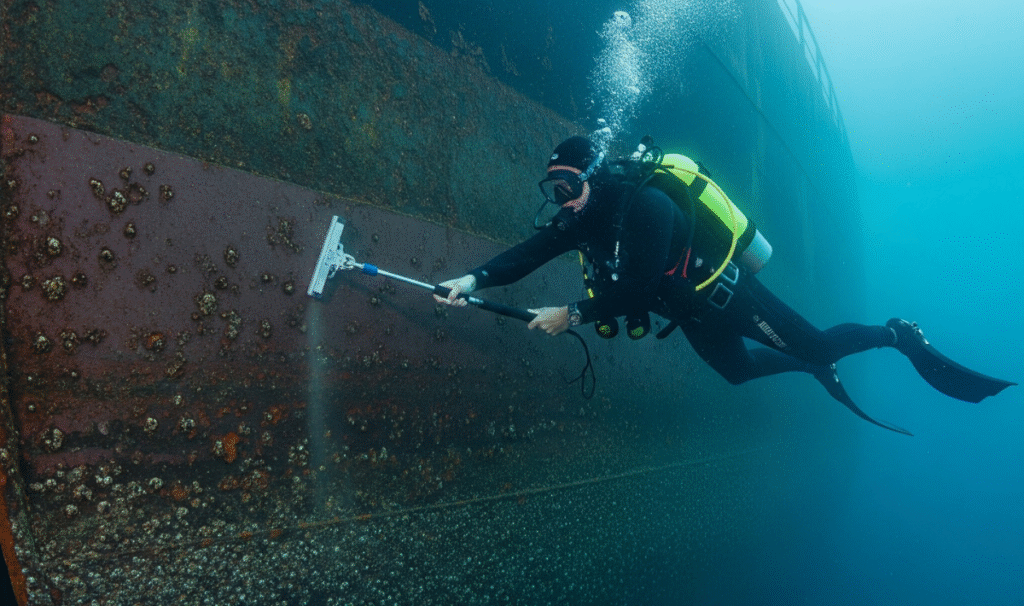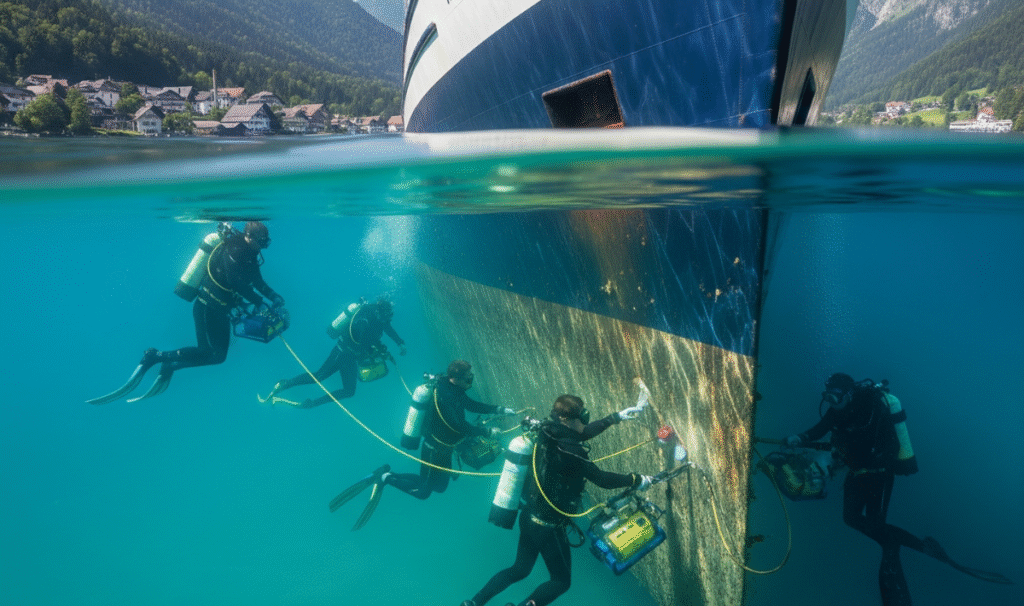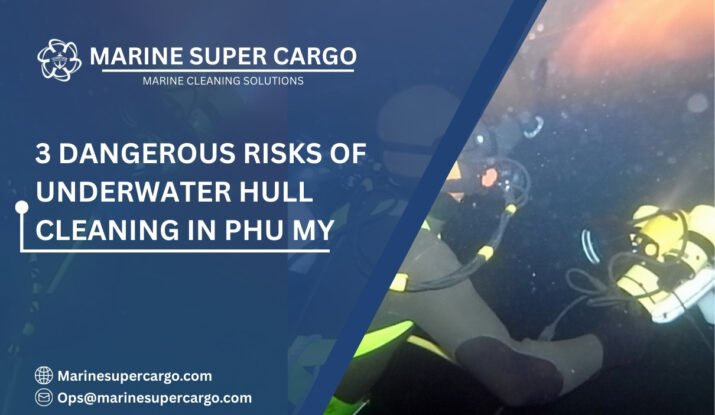In the heart of Vietnam’s rapid marine and industrial growth, Phu My Port stands as a vital shipping, trade, and energy hub. For captains, operators, and shipowners, underwater hull cleaning in Phu My is more than a matter of appearances—it’s the difference between running lean and racking up avoidable costs, penalties, and performance headaches. Join us as we dive into every aspect of underwater hull cleaning in Phu My, from urgent whys to practical how-tos.
Why Underwater Hull Cleaning in Phu My is Essential
Imagine your hull as a marathon runner’s shoe. When it’s caked in mud—think barnacles, algae, and mussels—it drags, making every stride waste energy. In the warm, nutrient-rich waters of Phu My, fouling organisms thrive year-round, quickly covering idle or active vessels. Regular underwater hull cleaning in Phu My slashes fuel consumption, boosts speed, protects coatings, and ensures seamless port entry under Vietnamese maritime regulations.
The Marine Environment of Underwater Hull Cleaning in Phu My and Fouling Challenges
Phu My’s strategic location near the mouth of the Cai Mep-Thi Vai River combines strong tidal flows, sediment-rich river water, and tropical heat. These factors ignite rapid fouling, especially for ships that anchor or sit in port for any length of time. Besides algae and barnacles, propellers, sea chests, and intakes are prone to clogging and corrosion, demanding a proactive, tailored cleaning approach.

Consequences of Neglecting Underwater Hull Cleaning in Phu My
Skipping cleaning means:
- Up to 20% higher fuel costs per voyage.
- Drag-induced delays, sluggish operations, and missed schedules.
- Accelerated damage to expensive hull coatings and underwater parts.
- Blocked intakes, overheating, and costly emergency repairs.
- Fines or denied entry for biofouling offenses, as Vietnamese port authorities are strict on compliance.
The Step-by-Step Process of Underwater Hull Cleaning in Phu My
Preparation, Dive Safety, and Regulations
Teams begin by checking water clarity, tidal flow, and traffic. Professional divers follow strict safety protocols, including real-time communication, surface support, and compliance with local port rules. Environmental permission and reporting to authorities are foundational to safe, legal jobs.
Tools, Technology, and Modern Cleaning Techniques
- Rotary brushes and hydraulic scrapers to remove biofouling gently while safeguarding coatings.
- Underwater vacuums and filtration systems to catch all debris before it impacts the sea.
- High-definition underwater cameras and ROVs (Remotely Operated Vehicles) for inspecting, mapping, and documenting hull conditions.
- Propeller polishing, sea chest, and intake cleaning are often bundled in a comprehensive service.
- Routine anode and sacrificial metal checks—prolonging the life of your hull and underwater systems.
How to Choose a Reliable Hull Cleaning Service in Phu My
Certifications, Experience, and Local Expertise
- Only consider providers with a commercial diver certification.
- Strong track record in Phu My or similar Vietnamese ports.
- Full insurance, safety compliance, and adherence to IACS, IMO, and Vietnamese port authority standards.
- Transparent pricing, reporting, and references from satisfied local clients.
Optimal Cleaning Frequency for Vessel Types
- Ships in Phu My benefit from cleaning every 1–3 months, depending on traffic, usage, and fouling levels.
- Idle or slower vessels, and those with complicated hull geometry or older coatings, should be cleaned more frequently.
Environmental Regulations and Responsible Cleaning Practices
Vietnamese authorities and port operators require:
- Complete capture and eco-friendly disposal of all biofouling material.
- Swift reporting of invasive species and compliance with both local and international rules (such as the IMO biofouling guidelines).
- Avoidance of hazardous chemicals, use of gentle cleaning on coatings, and minimal disruption to marine ecosystems.
- Thorough before-and-after documentation for client and regulatory review.
Cost Expectations for Underwater Hull Cleaning in Phu My
Most professional services charge between USD 6 and 14 per foot of hull, depending on ship size, biofouling extent, and extras like propeller polishing or emergency service. The modest upfront investment is quickly offset by ongoing fuel and maintenance, smoother port operations, and better regulatory standing.
DIY vs. Professional Services: Weighing the Risks
DIY might seem cheaper, but:
- Safety: Strong currents, busy port traffic, and limited visibility make DIY dives hazardous.
- Equipment: Professionals use specialized tech to ensure full, non-damaging cleaning.
- Legal/Compliance: Only certified, insured providers offer the necessary paperwork and meet port/state standards.
- Efficacy: Pros spot hidden issues and provide full reports for owners and insurers; DIY often misses problems.

The Benefits of Regular Underwater Hull Cleaning in Phu My: Fuel, Longevity, and Compliance
- Reduces drag, saving up to 20% on fuel costs.
- Maintains speed and agility—critical for tight schedules and quick port turnarounds.
- Keeps coatings and hulls in top condition, extending re-coat and repair cycles.
- Minimizes the risk of breakdowns or delayed sailings.
- Satisfies Vietnamese/IMO regulations and protects local ecosystems.
Testimonials from Phu My Mariners and Operators
One seasoned captain shared, “Our fuel burn dropped nearly 15% on local runs after our first professional cleaning at Phu My.” A shipping manager found smoother port inspections and fewer intake blockages after switching to a regular schedule. Even tourists noticed “quieter engines and faster cruises” on cleaned local ferries.
Conclusion: For Smooth, Sustainable Sailing in Phu My
Underwater Hull Cleaning in Phu My is your key to worry-free, high-performance operations in one of Vietnam’s most vital marine corridors. Trust certified, local experts to keep your hull spotless, stick to a smart cleaning schedule, and watch operational costs drop while compliance issues fade. The sea may be unpredictable, but with a clean hull, you control the journey.
FAQ:
Q1. How often should ships in the Phu My schedule undergo hull cleaning?
Every 1–3 months is recommended, with more frequent service for idle or heavily fouled vessels.
Q2. Are professional cleaning methods environmentally safe?
Yes—certified teams use debris containment, eco-friendly equipment, and techniques approved by Vietnamese authorities.
Q3. What are the typical costs for professional hull cleaning in Phu My?
USD 6–14 per foot, with extras for propeller polishing, inspections, or urgent calls.
Q4. Should I attempt DIY cleaning in Phu My?
DIY is discouraged—risks include safety hazards, legal issues, and poor results. Trust certified local professionals.
Q5. What are the main advantages of regular hull cleaning?
Lower fuel bills, faster trips, extended hull lifespan, regulatory compliance, and fewer breakdowns.


